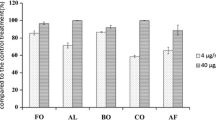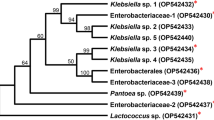Abstract
Eight bacterial isolates from the larval guts of Diamondback moths (Plutella xylostella) were tested for their plant growth–promoting (PGP) traits and effects on early plant growth. All of the strains tested positive for nitrogen fixation and indole 3-acetic acid (IAA) and salicylic acid production but negative for hydrogen cyanide and pectinase production. In addition, five of the isolates exhibited significant levels of tricalcium phosphate and zinc oxide solubilization; six isolates were able to oxidize sulfur in growth media; and four isolates tested positive for chitinase and β-1,3-glucanase activities. Based on their IAA production, six strains including four that were 1-aminocyclopropane-1-carboxylate (ACC) deaminase positive and two that were ACC deaminase negative were tested for PGP activity on the early growth of canola and tomato seeds under gnotobiotic conditions. Acinetobacter sp. PSGB04 significantly increased root length (41%), seedling vigor, and dry biomass (30%) of the canola test plants, whereas Pseudomonas sp. PRGB06 inhibited the mycelial growth of Botrytis cinerea, Colletotrichum coccodes, C. gleospoiroides, Rhizoctonia solani, and Sclerotia sclerotiorum under in vitro conditions. A significant increase, greater than that of the control, was also noted for growth parameters of the tomato test plants when the seeds were treated with PRGB06. Therefore, the results of the present study suggest that bacteria associated with insect larval guts possess PGP traits and positively influence plant growth. Therefore, insect gut bacteria as effective PGP agents represent an unexplored niche and may broaden the spectrum of beneficial bacteria available for crop production.
Similar content being viewed by others
References
Behar A, Yuval B, Jurkevitch E (2005) Enterobacteria-mediated nitrogen fixation in natural populations of the fruit fly Ceratitis capitata. Mol Ecol 14:2637–2643
Benson HJ (2002) Microbiological applications. McGraw Hill, Boston, MA, pp 170–200
Cattelan AJ, Hartel PG, Fuhrmann JJ (1999) Screening for plant growth-promoting rhizobacteria to promote early soybean growth. Soil Sci Soc Am J 63:1670–1680
Crowley DE, Reid CPP, Szaniszlo PJ (1988) Utilization of microbial siderophores in iron acquisition by oat. Plant Physiol 87:680–685
Dillon RJ, Dillon VM (2004) The gut bacteria of insects: Nonpathogenic interactions. Annu Rev Entomol 49:71–92
Gordon SA, Weber RP (1951) Colorimetric estimation of indoleacetic acid. Plant Physiol 26:192–195
Hameeda B, Rupela OP, Reddy G, Satyavani K (2006) Application of plant growth-promoting bacteria associated with composts and macrofauna for growth promotion of Pearl millet (Pennisetum glaucum L.). Biol Fertil Soils 43:221–227
Hameeda B, Reddy HK, Rupela OP, Kumar GN, Satyavani K (2006) Effect of carbon substrates on rock phosphate solubilization by bacteria from composts and macrofauna. Curr Microbiol 53:298–302
Hardy RWF, Holsten RD, Jackson EK, Burns RC (1968) The acetylene-ethylene assay for N2 fixation, laboratory and field evaluation. Plant Physiol 43:1185–1207
Huang YF, Chen CT, Kao CH (1993) Salicylic acid inhibits the biosynthesis of ethylene in detached rice leaves. Plant Growth Regul 12:79–82
Indiragandhi P, Anandham R, Madhaiyan M, Poonguzhali S, Kim GH, Saravanan VS, et al. (2007) Cultivable bacteria associated with larval gut of prothiofos-resistant, -susceptible, and field-caught populations of diamondback moth-Plutella xylostella and their potential for antagonism towards entomopathogenic fungi and host insect nutrition. J Appl Microbiol 103:2664–2674
Indiragandhi P, Anandham R, Kim KA, Yim WJ, Madhaiyan M, Sa TM (2007) Induction of defense responses in tomato against Pseudomonas syringae pv. tomato by regulating the stress ethylene level with Methylobacterium oryzae CBMB20 containing 1-aminocyclopropane-1-carboxylate deaminase. World J Microbiol Biotechnol (in press)
International Seed Testing Association (1993) Proceedings of the International Seed Testing Association: International rules for seed testing. Seed Sci Technol 21:25–30
Jacques MA, Kinkel LL, Morris CE (1995) Population sizes, immigration, and growth of epiphytic bacteria on leaves of different ages and positions of field grown endive (Cochorium endivia var. latifolia). Appl Environ Microbiol 61:899–906
Kremer RJ, Souissi T (2001) Cyanide production by rhizobacteria and potential for suppression of weed seedling growth. Curr Microbiol 43:182–186
Lauzon CR, Potter SE, Prokopy RJ (2003) Degradation and detoxification of the dihydrochalcone phloridzin by Enterobacter agglomerans, a bacterium associated with the apple pest, Rhagoletis pomonella (Walsh) (Diptera: Tephritidae). Environ Entomol 32:953–962
Lowry OH, Rosebrough NJ, Farr AL, Randall RJ (1951) Protein measurement with folin-phenol reagent. J Biol Chem 193:265–275
Massoumi A, Cornfield AH (1963) A rapid method for determining sulphate in water extracts of soils. Analyst 88:321–322
Maxwell PW, John GC, Webster M, Dunphy GB (1994) Stability and activities of antibiotics produced during infection of the insect Galleria mellonella by two isolates of Xenorhabdus nematophilus. Appl Environ Microbiol 60:715–721
Meyer JM, Abdallah MA (1978) The fluorescent pigment of Pseudomonas fluorescens: Biosynthesis, purification and physicochemical properties. J Gen Microbiol 107:319–328
Murphy J, Riley JP (1962) A modified single solution method for the determination of phosphate in natural waters. Anal Chim Acta 27:31–36
Nagarajkumar M, Bhaskaran R, Velazhahan R (2004) Involvement of secondary metabolites and extracellular lytic enzymes produced by Pseudomonas fluorescens in inhibition of Rhizoctonia solani, the rice sheath blight pathogen. Microbiol Res 159:73–81
Nautiyal CS, Mehta S, Singh HB (2006) Biological control and plant-growth promotion by Bacillus strains from milk. J Microbiol Biotechnol 16:184–192
Nelson N (1944) A photometric adaptation of the Somogyi method for the determination of glucose. J Biol Chem 153:375–380
Nguyen C, Yan W, Le Tacon F, Lapeyrie F (1992) Genetic variability of phosphate solubilizing activity by monocaryotic and dicaryotic mycelia of the ectomycorrhizal fungus Laccaria bicolor (Maire) P.D. Orton. Plant Soil 143:193–199
Pandey A, Trivedi P, Kumar B, Palni LMS (2006) Characterization of a phosphate solubilizing and antagonistic strain of Pseudomonas putida (B0) isolated from a sub-alpine location in the Indian central Himalaya. Curr Microbiol 53:102–107
Paul VJ, Frautschy S, Fenical W, Nealson KH (1981) Antibiotics in microbial ecology: Isolation and structure assignment of several new antibacterial compounds from the insect symbiotic bacteria Xenorhabdus spp. J Chem Ecol 7:589–597
Penrose DM, Glick BR (2003) Methods for isolating and characterizing of ACC deaminase-containing plant growth promoting rhizobacteria. Physiol Plant 118:10–15
Pikovskaya RI (1948) Mobilization of phosphorous in soil in connection with the vital activity of some microbial species. Mikrobiologiya 17:362–370
Rustrian E, Delgenes JP, Moletta R (1997) Phosphate release and uptake by pure cultures of Acinetobacter sp.: Effect of the volatile fatty acids concentration. Curr Microbiol 34:43–48
Saravanan VS, Madhaiyan M, Thangaraju M (2007) Solubilization of zinc compounds by the diazotrophic, plant growth promoting bacterium Gluconacetobacter diazotrophicus. Chemosphere 66:1794–1798
Schwyn B, Neilands JB (1987) Universal chemical assay for the detection and determination of siderophores. Anal Biochem 160:47–56
Swain MR, Ray RC (2007) Biocontrol and other beneficial activities of Bacillus subtilis isolated from cow dung microflora. Microbial Res (in press)
Vilmos P, Kuruez E (1998) Insect immunity: Evolutionary roots of the mammalian innate immune system. Immunol Lett 62:59–66
Wani PA, Khan MS, Zaidi A (2007) Chromium reduction, plant growth-promoting potentials, and metal solubilization by Bacillus sp. isolated from alluvial soil. Curr Microbiol 54:237–243
Wainright M (1984) Sulfur oxidation in soils. Adv Agron 37:350–392
Acknowledgments
The authors acknowledge the financial support given by a BK21 Research Fellowship through a doctoral fellowship to P. Indiragandhi and the Agricultural Research Promotion Center (Republic of Korea). Also, thanks are due to Dr. V. S. Saravanan and Dr. P. Trivedi for their critical reading of this manuscript.
Author information
Authors and Affiliations
Corresponding author
Rights and permissions
About this article
Cite this article
Indiragandhi, P., Anandham, R., Madhaiyan, M. et al. Characterization of Plant Growth–Promoting Traits of Bacteria Isolated from Larval Guts of Diamondback Moth Plutella xylostella (Lepidoptera: Plutellidae). Curr Microbiol 56, 327–333 (2008). https://doi.org/10.1007/s00284-007-9086-4
Received:
Accepted:
Published:
Issue Date:
DOI: https://doi.org/10.1007/s00284-007-9086-4




